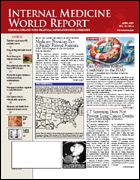Publication
Article
Internal Medicine World Report
Primary Care Physicians Score Well on Hypertension Management in Diabetic Patients
Author(s):
Diabetes Care
Primary care physicians oversee more than 90% of the care for patients with diabetes. With studies usually showing suboptimal care of both diabetes and high blood pressure (BP) in primary care, it may come as a surprise that a recent study found no evidence that hypertension was poorly managed in diabetic patients by primary care physicians (. 2006; 29:2580-2585).
Short questionnaires were sent to 26 primary care practices, to be completed after each visit with a nonpregnant adult with type 2 diabetes. Surveys were completed for 778 patient encounters (63% women; 48% Hispanic; mean age, 58.1 years).
BP exceeded the goal of <130/80 mm Hg about 66% of the time (n = 478), but in 42% of these cases, BP was “near goal” (ie, <140/90 mm Hg).
Physicians reported taking action in 35% of patients, a rate that may seem deceptively low. And although actions were taken in only 13% of the patients whose BP was “near goal,” the action rate ballooned to 51% in those whose level was “above previous goal” (ie, ≥140/90 mm Hg).
IMWR
“The study was designed to look both at predictors of action and levels of treatment in response to a given blood pressure reading, as well as to assess reasons medical providers gave for inaction,” lead investigator Paul C. Hicks, MD, tells . “It is an important distinction to draw—that all inaction does not represent poor care.”
The 3 factors that predicted action were:
• The extent of BP elevation
• The number of drugs the patient was already taking
• Whether the patient was already on antihypertensive therapy.
The leading reasons for taking no action were:
• BP was at/near goal (54%)
• Competing demands (17%)
• It was a new or transient increase (17%).
“Inaction occurs in practice for a number of legitimate clinical indications,” says Dr Hicks, who practices at the Salud Family Health Center in Fort Lupton, Colo. “In our minds, though, inaction based on the medical provider’s perception that the patient was actually at or near the goal, when in fact he was more distant from these goals, may represent poor care. As such, given that low overall percentage of these cases compared to the total population studied, there did not appear to suggest patterns of routinely poor care.”
IMWR
Is there a level above which antihypertensive therapy should be initiated in a patient with diabetes? “I don’t think there is a line in the sand for ‘must treat’ blood pressure in diabetes,” coinvestigator Bennett Parnes, MD, of the University of Colorado Health Sciences Center in Aurora, tells .
“Guidelines should guide our care, not dictate it. Life expectancy plays a role. For a patient with less than 2 years to live, intensive blood pressure management doesn’t make sense,” Dr Parnes says.
Dr Hicks agrees: “This truly gets to the intersection of science and art in medicine. Does a given blood pressure reading carry the same significance in a patient on hospice with metastatic colon cancer as in a 32-year-old patient with no other comorbidity besides hypertension and diabetes? Likely, most physicians would say no. Considering that then, where is the line in the sand that one draws? And are different lines drawn by different physicians acceptable and justifiable?”
He is confident his coinvestigators would agree “that we are not able to speak for all of medicine and to determine its distinctions of quality into black and white. This study is our attempt to better define those areas of gray that are so common in our field.”
Key points
• According to this study, primary care physicians properly manage hypertension in diabetic patients.
• BP exceeded the goal about 66% of the time but was near goal in 42% of the cases.
• Overall, physicians took action in 35% of cases, but this rate ballooned to 51% in patients whose BP was above previous goal.
• Action predictors included: extent of BP elevation, number of drugs the patient took, and whether the patient was already using antihypertensives.






